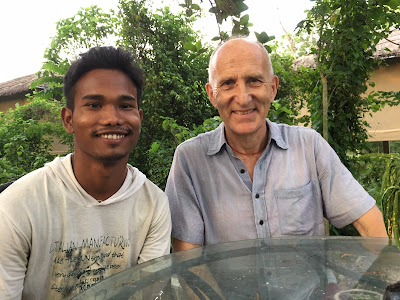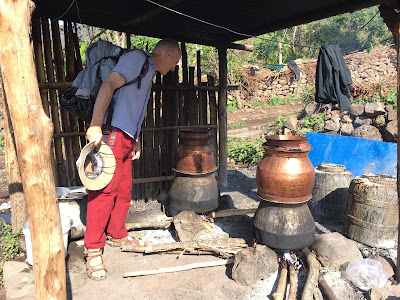One of the students at the Veterinary Teaching Hospital asked me to join him and some of his family on an overnight excursion to Devchuli Hill. This was for a devotional trip on the first full moon after the Nepali new year.
The 'hill' is 1936 metres high and would probably be classified as a mountain in most countries. However, when compared with the Himalayas, it is just a hill!
Devchuli Hill is in the Nawalpur district of Nepal. It is sacred to people belonging to the Tharu ethnic group; like my veterinary student friend, Prem.
The Tharu people are indigenous to the Terai region of Nepal. This is the lowland region bordering India. It used to be infested with malaria carrying mosquitoes. The Tharu people were the only group who could survive here because they were resistant to malaria. In fact, criminals used to be sent from other areas to the Terai region as a punishment since they would soon die from malaria! However, since DDT was introduced in the mid 1950's, the incidence of malaria has reduced and many other people now also live in the Terai.
Here are some of Prem's relatives outside a typical Tharu house in the village of Agyauli, near Kawasoti:
I think the girls dressed up in their best in honour of my visit!
Note the long grass fibre mat laid out in front of the house to dry grain in the hot sun.
Frames for the walls are constructed using bamboo and reeds before covering in mud. The roof is often thatched and the floors are dried earth.
The Narayani river flows through this area and is fished from dug out canoes or using nets thrown from the shore:
Fish traps were also used earlier. These resemble the designs of traps made by the aboriginal people in Australia and other early cultures.
I stayed overnight in Prem's house and the journey to Devchuli Hill started early the next morning. We woke at 3am ... after little sleep. This is because there is a television in the house ... and Prem's father switches it on if he can't get to sleep ... which prevents everyone else from sleeping! Meanwhile he falls asleep and I had to listen to the main characters of a romantic Bollywood movie crooning to each other with the full support of an orchestra and chorus.
Our group consisted of 9 people, one male goat, and a couple of woven baskets each containing a pair of fledgling pigeons.We proceeded to walk 3 kilometres by the light of the moon, along mostly dirt tracks, and across a dry riverbed, before joining the Mahendra Highway. Unfortunately, a Bandha (strike) had been announced for that day ... so there were no local buses. We walked along the highway for another couple of kilometres trying unsuccessfully to stop one of the passing long distance coaches. Eventually, a kind policeman who was on duty to enforce the closure of local travel and businesses, walked into the middle of the road and flagged a bus down for us in Kawasoti. Of course, all the buses were full. So we had to divide our group into 3 loaded buses and stand in the passageway for the next 12 kilometres. The third bus had no option but to take the goat.
We
were lucky to find a couple of tuk tuks that were ignoring the bandha
when we got off the bus at Daldale.The drivers agreed to take us the next step of our journey along a
small subsidiary road to a little village in the foothills called Munde; with the pigeons in one vehicle
and the goat in the other.
Here we are before packing ourselves into the tuk tuks (3-wheeled auto rickshaws):
The rest of our pilgrimage was on foot; carrying our clothes, tent shelter, food and cooking utensils.
We stopped to prepare lunch over open fires at a small hill-village called Kirtipur. A couple of stills were busily working away to produce the local 'raksi' (an alcoholic drink made from rice).
Recipe: yeast is added to cooked rice which then sits for a couple of weeks before being transferred into a large bronze pot. A big clay (or metal) pot with some holes in the bottom of it is placed on top of the large bronze pot. Inside this, is a small clay pot. A bronze pot with a cone shaped bottom is placed above the middle pot. The still is heated with burning logs and the alcohol is condensed by filling the cone shaped container with cold water. The alcohol drips off the tip of the cone and is collected in the little clay pot. The water is changed up to 6 or 7 times for the best saki flavour.
WARNING: Do NOT try this recipe at home without proper adult supervision!
The local kids use the open irrigation channels as slippery-slip slides:
While lunch was being prepared, the priests began chanting and playing the madal (Nepali drum). This induced some of the men to go into a trance where they leapt around throwing themselves onto the ground. This was an amazing spectacle to watch! It went on for more than an hour. Over a dozen different men went into a trance; sometimes repeatedly. One young man must have been affected 5 or more times.
It was another 2 - 3 hours before we reached our camp site at the base of Devchuli Hill. We erected makeshift tents in and around the dry riverbed ...
... until the place looked like 'Tent City'.
There were over 150 'tents'. Each shelter housed between 4 and 15 occupants. I estimated over a thousand people!
We obtained our water by digging trenches in the dry riverbed. These filled with water quite quickly.
On one occasion, 4 women suddenly appeared out of the jungle behind our tent. Each lady carried a huge load of branch cuttings on her back as fodder for their buffaloes. They must have spent the whole day searching for the branches, cutting them, and carrying them home.
Note the bare feet!
The next morning, we rose at 1am. Fires were lit and everyone went to bathe in the water holes before returning to warm themselves by the fire. The priests blew on conches and we all followed them up the steep path into the jungle. The scene was mystical. It was fairy-like. Every second or third person carried a torch. So imagine what the procession looked like as over 1000 people headed up the steep path into the jungle in single file. It was like a scene from a classic children's book (I wish I could remember the title!).
The trees cut out most of the light from the full moon ... so of course we lost the path on several occasions! However, everybody reached the destination which was a cave near the top of the hill. It was daylight by now. Everyone clustered round the mouth of the cave when they arrived.
There was excitement, curiosity and reverence. The cave interior is smaller than a tennis court. As well as the priests, it contained 3 small golden statues that people queued to worship. There were also 3 mummified heads suspended on a wall. These belonged to 3 members of a different ethnic origin who entered the cave without proper authority! No photos were taken. Not because it is prohibited ... but because all attempts to take photos fail!
I was not permitted inside the cave because I am not Tharu. Neither was Prem permitted ... because his uncle had died during the previous year. So we continued further on to the top of the hill.
The views were spectacular. This is the view south; looking over other hilltops towards the Terai region. Unfortunately, visibility is severely reduced by the thick layer of brown haze that can be seen below the blue sky. This is part of the Asian Brown Cloud (ABC) that extends over a huge area from Pakistan to China. It is the same cloud of pollution that affects major cities such as Karachi, Shanghai and Peking. (Google it ... because most of us are blissfully unaware of it!). The tops of the Himalayan range could barely be seen peaking through the cloud of pollution when looking north. What a glorious sight it would have been if only the air had been less polluted.
I predict that trekking in Nepal will reduce drastically as people realise the Himalayas can no longer be readily seen in their splendour. Similarly, tourists to the Great Barrier Reef off the Australian coast will stop coming if destruction to the coral reef does not stop.
On a brighter note, Prem found a rhododendron tree in flower:
We all returned to our camp later the same morning. All, that is, except for the goats and pigeons that people had cared for during the trek. They were unaware of the sacrificial fate that awaited them when they arrived at the cave.
We passed a farmlet nestled on a shoulder of the mountain on our way down. The buildings were of similar construction as those on the Terai ... although this one is 2 storied and has a thatched roof.
Back at camp, it was time to dissemble our tent and head downhill.
We carried the now headless goat with us. He was to be part of lunch. Firstly, the hair from the skin was removed by singeing it off:
Then, the goat was butchered:
Some of the meat was cooked and the rest was carried home.
The food is served in large brass plates. Servings are generous and second helpings are encouraged. Here is an example of the amount of rice per serve:
The curried dish you can see is alu gundruk. Alu is a potato tarkari (curry). Gundruk is made by drying green vegetable leaves for a couple of days in the sun until they are well wilted. Then, shred them unevenly and pack tightly into an airtight wooden, earthenware or glass jar for a few days in the sun until they ferment to produce a strong sour smell. It is ready to be eaten after sun drying again for several days. Not everybody likes gundruk.
By the time we reached Kirtipur, everyone was exhausted. So it was a pleasant surprise to find a 4-wheel drive vehicle that would take us back to the main highway. Imagine 30 people, plus luggage, fitting into ( ... and onto!) an old Land Rover or Land Cruiser. This is what it would look like:
... and here is the view from the vehicle's roof top:
The peak on the left is Devchuli Hill.
I feel privileged and honoured to have been invited to join my Nepali friends on this special occasion.
Thank you.




















No comments:
Post a Comment